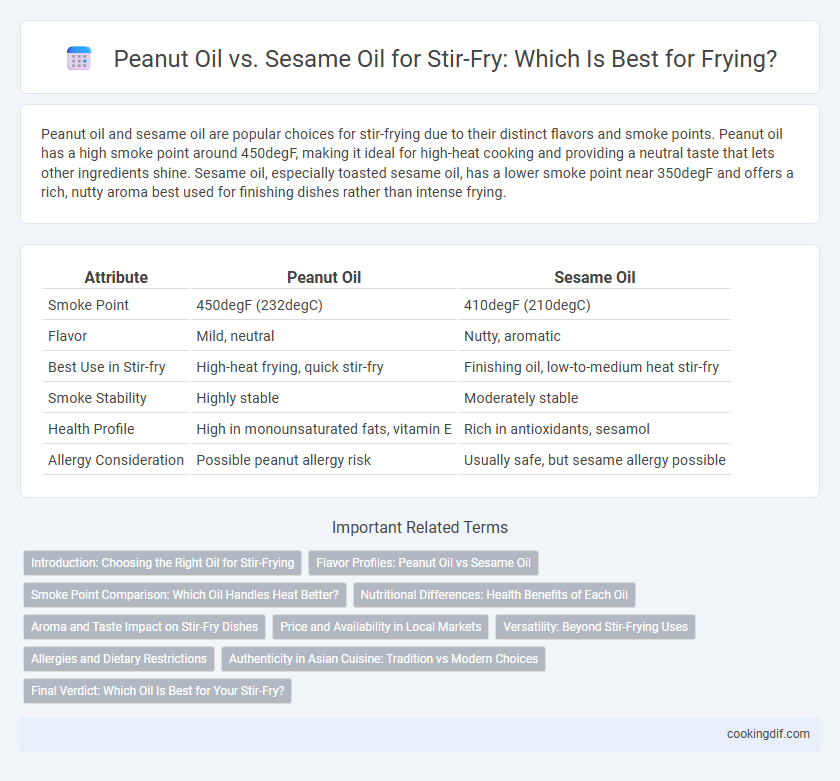Peanut oil and sesame oil are popular choices for stir-frying due to their distinct flavors and smoke points. Peanut oil has a high smoke point around 450degF, making it ideal for high-heat cooking and providing a neutral taste that lets other ingredients shine. Sesame oil, especially toasted sesame oil, has a lower smoke point near 350degF and offers a rich, nutty aroma best used for finishing dishes rather than intense frying.
Table of Comparison
| Attribute | Peanut Oil | Sesame Oil |
|---|---|---|
| Smoke Point | 450degF (232degC) | 410degF (210degC) |
| Flavor | Mild, neutral | Nutty, aromatic |
| Best Use in Stir-fry | High-heat frying, quick stir-fry | Finishing oil, low-to-medium heat stir-fry |
| Smoke Stability | Highly stable | Moderately stable |
| Health Profile | High in monounsaturated fats, vitamin E | Rich in antioxidants, sesamol |
| Allergy Consideration | Possible peanut allergy risk | Usually safe, but sesame allergy possible |
Introduction: Choosing the Right Oil for Stir-Frying
Peanut oil offers a high smoke point around 450degF, making it ideal for high-heat stir-frying and delivering a neutral flavor that enhances the dish's natural taste. Sesame oil, with a lower smoke point near 350degF, is best used for finishing or light sauteing to impart a rich, nutty aroma typical in Asian cuisine. Selecting peanut oil or sesame oil depends on desired cooking temperature and flavor profile for optimal stir-fry results.
Flavor Profiles: Peanut Oil vs Sesame Oil
Peanut oil offers a mild, neutral flavor with a high smoke point, making it ideal for stir-frying without overpowering the dish's natural ingredients. Sesame oil, particularly toasted sesame oil, imparts a rich, nutty aroma and distinctive flavor that enhances Asian-inspired recipes but is better used as a finishing oil rather than for high-heat frying. Choosing between the two depends on whether a subtle taste or a pronounced sesame essence is desired in the stir-fry.
Smoke Point Comparison: Which Oil Handles Heat Better?
Peanut oil has a higher smoke point, typically around 450degF (232degC), making it ideal for high-heat stir-frying without burning or producing harmful smoke. Sesame oil's smoke point is lower, approximately 350degF (177degC), which suits medium-heat cooking and finishing dishes for flavor rather than intense frying. Choosing peanut oil ensures better heat stability and crisp textures in stir-fry recipes that require sustained high temperatures.
Nutritional Differences: Health Benefits of Each Oil
Peanut oil contains higher monounsaturated fats, which support heart health by lowering bad cholesterol levels, while sesame oil offers rich antioxidants like sesamol and sesamin that reduce inflammation and protect cells from oxidative damage. Peanut oil provides more vitamin E, enhancing skin health and immune function, whereas sesame oil contains beneficial lignans that may improve blood pressure regulation and have anti-cancer properties. Both oils have unique nutritional profiles that contribute to a balanced diet when used appropriately in stir-fry cooking.
Aroma and Taste Impact on Stir-Fry Dishes
Peanut oil offers a neutral aroma and a mild, slightly nutty flavor that enhances stir-fry dishes without overpowering other ingredients. Sesame oil, especially toasted sesame oil, provides a robust, aromatic profile with a deep, nutty taste that significantly intensifies the flavor complexity of stir-fry. Choosing peanut oil maintains the dish's original taste balance, while sesame oil adds a distinctive richness and signature Asian flavor character.
Price and Availability in Local Markets
Peanut oil generally offers a more affordable price point compared to sesame oil, making it a popular choice for everyday stir-fry cooking in many local markets. Its widespread availability in grocery stores and supermarkets ensures easy access for consumers seeking budget-friendly options. Sesame oil, while more expensive due to its distinctive flavor and extraction process, is often found in specialty or Asian markets, limiting its accessibility for some buyers.
Versatility: Beyond Stir-Frying Uses
Peanut oil and sesame oil both excel in versatility beyond stir-frying, with peanut oil's high smoke point making it ideal for deep frying, roasting, and sauteing a wide range of dishes. Sesame oil, especially the toasted variety, is prized for its robust flavor that enhances dressings, marinades, and finishing touches in Asian cuisine. Choosing between the two depends on desired flavor intensity and cooking technique, as peanut oil provides a neutral base while sesame oil offers distinctive aromatic notes.
Allergies and Dietary Restrictions
Peanut oil is commonly used for stir-frying due to its high smoke point but poses a significant allergenic risk for individuals with peanut allergies. Sesame oil offers a distinctive flavor and is suitable for those avoiding peanuts, but it may trigger allergic reactions in people sensitive to sesame seeds, which are also a common allergen. Choosing between peanut and sesame oil requires careful consideration of specific dietary restrictions and allergy concerns to ensure safe cooking.
Authenticity in Asian Cuisine: Tradition vs Modern Choices
Peanut oil, prized for its high smoke point and neutral flavor, is traditionally favored in authentic Asian stir-fry recipes, preserving the dish's genuine taste and texture. Sesame oil, with its robust aroma and distinctive nutty flavor, is often used as a finishing oil rather than for frying to maintain traditional flavor profiles without overpowering the stir-fry. Modern culinary trends sometimes blend these oils to balance authenticity with innovative taste, enhancing both traditional and contemporary Asian cuisine.
Final Verdict: Which Oil Is Best for Your Stir-Fry?
Peanut oil offers a high smoke point around 450degF, making it ideal for high-heat stir-frying with a neutral flavor that lets the ingredients shine. Sesame oil, especially toasted sesame oil, has a lower smoke point near 350degF and delivers a rich, nutty aroma best suited as a finishing oil rather than for intense cooking. For optimal stir-fry results, using peanut oil during cooking and adding a drizzle of sesame oil at the end enhances both texture and flavor.
Peanut oil vs Sesame oil for frying Infographic

 cookingdif.com
cookingdif.com